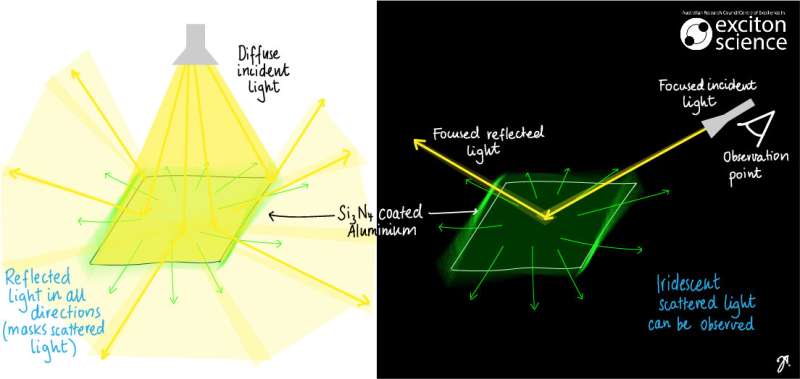Now you see it, now you don't: Hidden colours discovered by coincidence

Scientists in Australia have stumbled across an unusual way to observe color that had previously gone unnoticed.
To create the effect, researchers attached a very thin film of one material to another, larger sample. The electric field (an invisible force created by the attraction and repulsion of electrical charges) is very strong where the two materials are connected.
When combined with 'optical interference' (the interaction of different waves of light), a scattering process occurs from the surface of the material, creating bright colors when viewed under different lighting conditions.
The findings, which have been published in the journal Advanced Optical Materials, have expanded our understanding of the behavior and properties of light, and could also have practical applications in sensing technology and security devices.
How do we see color?
Most materials in the world around us appear a certain color because they only absorb part of solar spectrum. For example, leaves on a tree look green to us because they absorb red and blue light.
However, some objects, animals and materials create color a different way, because of the properties they contain. These are known as structural colors.
Structural colors are usually created by diffraction, which happens when rays of light interfere with each other as they reflect off surfaces. Rainbows and colorful oil slicks on top of water are examples of structural color, and the effect is also responsible for the amazing vivid hues of peacock feathers and butterfly wings.
Now there's a new way
While those phenomena are well established, an unexpected new mechanism for creating similar effects has been uncovered.
The effect is an example of structural color forming because of frequency-selective scattering of light, in which the strength of the electric field and the type of material used is a key factor.
Dr. Eser Akinoglu of the ARC Centre of Excellence in Exciton Science was using a light microscope to observe gold nanoparticles when he unexpectedly noticed that the entire sample was creating a vivid color visible to the naked eye from all directions.
Eser asked for help from colleagues at The University of Melbourne, CSIRO, South China Normal University and the University of Bayreuth to explain the mystery.
To understand it properly, they created thin films which could scatter light and at the same time create diffraction or interference. The system was made using silicon nitride coatings on larger metallic aluminum samples.
Different colors were visible by changing the lighting conditions. Under normal light, the samples looked like a mirror, reflecting back almost all visible light. But turning the overhead lights off and using only one beam of light to illuminate the sample produces vivid, iridescent colors.
Explaining how to easily observe this phenomenon, Eser said: "If you use a flashlight, while in a dark room, to illuminate the sample, the reflected light beam travels away from you to the other side of the room.
"The reflected light never reaches your eyes, only the scattered light can reach your eyes. Whereas when the room light is on, light comes from everywhere on to the sample and therefore you will always see reflected light traveling into your eyes.
"The effect is a previously completely unrecognized curiosity that results in us seeing color. It's fundamentally something different."
More information: Eser Metin Akinoglu et al. Concealed Structural Colors Uncovered by Light Scattering, Advanced Optical Materials (2020). DOI: 10.1002/adom.202001307
Journal information: Advanced Optical Materials
Provided by ARC Centre of Excellence in Exciton Science





















